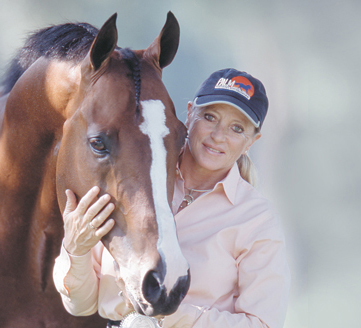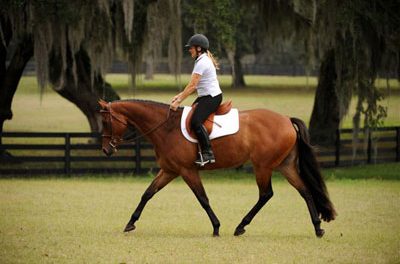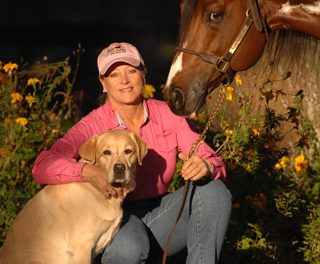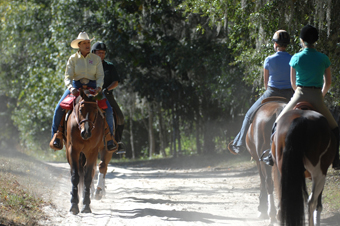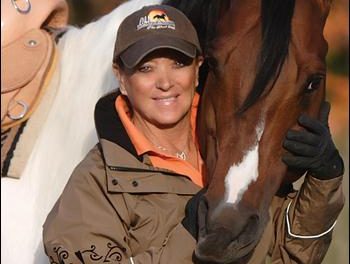Building A Partnership With Your Horse
 In this article, I will continue with possible trail training problems by discussing the issue of the “spooky” horse. A lot of the information given in the first four parts of this series on how to prepare your horse for his first trail ride is applicable in dealing with a spooky horse and you should go back and review that information.
In this article, I will continue with possible trail training problems by discussing the issue of the “spooky” horse. A lot of the information given in the first four parts of this series on how to prepare your horse for his first trail ride is applicable in dealing with a spooky horse and you should go back and review that information.
For safety’s sake in a situation where you may want to dismount, you may want to ride with a halter over or under your bridle. Be sure that it does not interfere with the bridle fit. Attach a long lead or longe line to the halter. This can be looped around your saddle horn or held in your free hand. Never attach it to yourself in any way. Always use a cotton line, not nylon, which can cut your hand.
Always use your senses when you ride. Look for changes in shadow and light on the trail, logs, rocks, or anything else that your horse may find unsettling. Open your ears to sounds. You will find that you hear things much more clearly when your focus is on the trail ahead and not directly on your horse. Your horse usually will smell or hear another animal on the trail before they actually become visible.
If your horse has been on a trail before and he has spooked or resisted, figure out the reason why this happened. Was he reacting to something permanent that cannot be changed along the trail, such as a tree stump or water crossing? Or, did he spook at something temporary, like a gust of wind, a grouse that he flushed out, or a sound in the bushes?
If it was something permanent on the trail, on your next trail ride get off his back and on the ground before reaching the object that he spooked at before. It is vital in controlling a spooky horse to stop him before he decides to spook or before he decides to stop because he is unsure of an object. In this way you keep control, and you can have the horse address the offending obstacle before he stops and spooks in fright.
In order to be able to do that, you must be alert to the horse’s body language. Watch for the cues that tell you he is getting ready to spook—his ears are alert, his eyes get bigger, his breathing gets stronger. As soon as you hear breathing that is stronger than normal, stop and dismount.
While on the ground, be sure to give the horse his head to let him study the obstacle and swing his head to see it with both eyes. After he studies it and seems to accept the obstacle, take a few steps towards it. Stop again and let the horse study it from this closer proximity. When he appears to accept it at this range, continue the process until you reach the spooky obstacle. Allow him to smell it. This really will help him accept the obstacle and give him confidence.
Even when he seems to accept the obstacle, the lesson is not yet over. He must learn to accept it when it is behind him and when he is approaching it from the opposite direction. In the first situation, the scary obstacle that he accepted and walked past is now behind him. Horses sometimes show more spookiness when an obstacle is behind them. This is because a horse is a flight animal. Once he has passed a spooky spot, his reaction may be to flee or overreact and spook further away from it.
In the second situation, a horse may spook at an object when approaching it from a different direction even though he has accepted it before. This is because a horse sees things differently from each direction. If you get him accustomed to the scary obstacle coming at it only from one direction, then when he approaches it from another direction he may ignore it, spook with the same level of concern as before, or spook even worse. Be sure to desensitize him to obstacles from all directions!
As you leave a spooky spot, such as walking past a stump, take a step or two and stop. Let him swing his head and look at the spot with both eyes. If he moves and does not stand still, reposition him exactly where you asked him to stop. Do not circle to reposition him. If he moves to the right, reposition him to the left, and vice versa. If he moves forward, back him to the exact spot where you asked him to stop. Do the same if he moves backward. This is very important to do to keep his respect and keep you in charge of the situation. Get him accustomed to approaching the scary spot from all directions.
Remember, when you are on the ground, be ready to use the “move away from me” commands. The horse’s first instinct will be to herd and get close to you. This is dangerous, and it puts him in control of the situation. Do not let him move on top of you! Make him move away and respect your space as he learns to accept the obstacle.
When you are between 15 and 20 feet away from the obstacle, remount and move on to whatever you were doing prior to the spookiness. Continue with the same short segments if his spookiness returns. Take a few steps, stop, study the obstacle, etc. The more time you take to let him study an obstacle, the shorter time it will take him to accept it. On the other hand, if you rush this process or force him, it will take you longer to get him to accept it.
In the next article, I will continue on with the problem of the spooky horse. In the meantime, my E-Book, Training Outside the Box, is available online at www.lynnpalm.com along with other valuable training products. You also may contact us at 800-503-2824.

